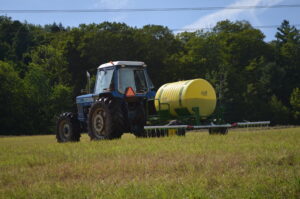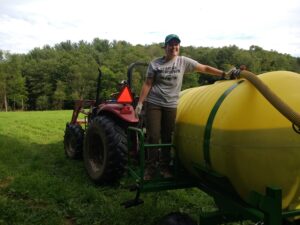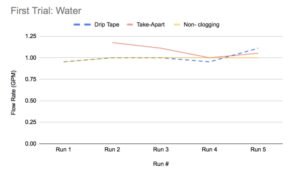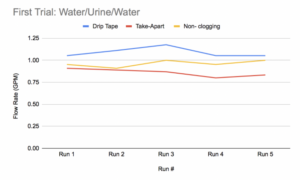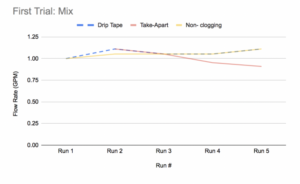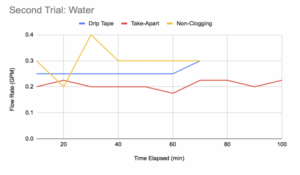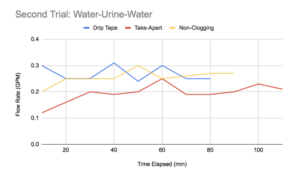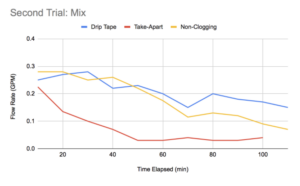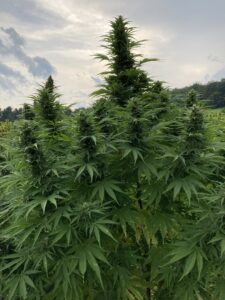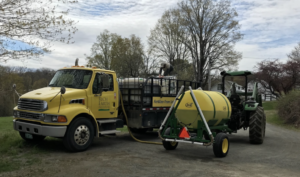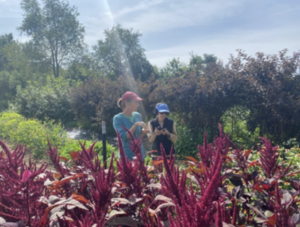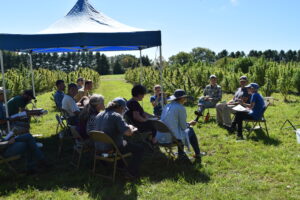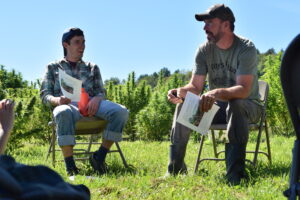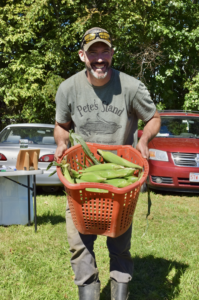Final report for ONE20-375
Project Information
Fertilizers made from human urine are a sustainable and abundant source of nitrogen and other agricultural nutrients. Previous field research has established their effectiveness for growing hay, while social research has revealed areas where farmers would like additional information before trying urine-derived fertilizers on their own farms. This research project combined two activities: 1) a collaborative demonstration of urine-derived fertilization on five farms, growing hemp, hay, figs, cut flowers, and corn, and 2) a controlled fertigation experiment using urine-derived fertilizer and hard irrigation water, evaluating the ability of three types of drip irrigation emitter to resist clogging.
The project involved partner farmers in all the stages of planning, execution, and evaluation. The project addressed needs and interests expressed by farmers interviewed in our previous SARE project (ONE18-318), many of whom were open to urine fertilization, but wanted more concrete information on application methods and plant response for specific crops. The broad themes of this project, including the focus on drip fertigation, matched the interests of the farmer partners. The details of the specific on-farm demonstration experiments were determined by the farmers in order to best support their farming objectives.
All the farmer-partners reported positive results from their experiments, with either comparable or better yields and/or robustness from their urine treated plants. One farmer reported increased cannabinoid content of his CBD hemp in a sample of his urine-treated crop, and another found increased potassium and micronutrients in his urine-treated corn as compared to controls. All indicated interest in further experimentation, and had suggestions for future research.
The drip-irrigation trial showed that urine can successfully be delivered via fertigation either by mixing it with irrigation water or by delivering it in an alternating fashion with the irrigation water.
Outreach included a field day held in September at Hubbard CBD; a farm-partner gathering held in February, 2022 to share results and brainstorm future research projects; a presentation for the NOFA Vermont winter conference; publicity via Rich Earth’s communication platforms and international networks; and an article for publication in a relevant trade journal such as The Natural Farmer or Growing for Market (still in progress).
This project sought to demonstrate the effect of urine-derived fertilizer on the development and yield of a variety of crops, while testing application methods and fertilizer formulations chosen to meet plant needs while minimizing harmful nutrient migration into the wider environment.
Objective 1: Develop fertilization plans for each crop, including urine-derived fertilizer type and application method. Conduct side-by-side demonstrations, comparing urine-derived fertilizer to typically-used fertilizer for each crop. Document farmer experiences and plant response.
Objective 2: Conduct a controlled experiment testing the incidence of clogging when urine fertilizer is injected into drip fertigation systems fed with hard water. Test two injection methods and three emitter types, in an accelerated two-season laboratory simulation.
Demonstrating the effect of urine fertilizer on a variety of crop types is essential to helping more farmers become familiar with and potentially adopt this practice. Testing drip fertigation using urine, to determine what conditions are necessary for successful operation, was undertaken so as to make available an application method that is ideally matched to the characteristics of urine. Farmers can benefit from an increased ability to effectively utilize a new low-cost and sustainable source of nitrogen fertilizer.
By diverting human urine from the wastewater stream and transforming it into fertilizer, we are beginning to solve two major problems: pollution of sensitive waterways with nutrients from wastewater, and dependence of agriculture on unsustainable sources of fertilizer. The proposed project builds on previous work, improving methods for meeting plant nutrition needs using sustainable fertilizer made from urine.
Most nitrogen fertilizer is derived from the Haber-Bosch process, which accounts for 1.2% of global energy use and associated greenhouse gas emissions (Dawson & Hilton 2011), while high-N amendments used by organic farmers are expensive and supplies are uncertain. Phosphate is a finite resource, subject to politically induced price swings, and the Global Phosphorus Research Initiative is predicting a shortage of high-quality rock phosphate within 40 years.
Surface waters throughout the Northeast are heavily impacted by nitrogen and phosphorus pollution caused by human activity. Agriculture is a major contributor, but wastewater from homes and businesses can be the principal source of nutrient pollution in more populated watersheds, primarily due to the urine it contains. Seventy percent of the nitrogen and 50% of the phosphorus in wastewater is from urine, with feces contributing a relatively small share. Many wastewater plants and most septic systems are unable to control this nutrient pollution and are poorly suited to nutrient reclamation.
Although still uncommon, urine diversion is gaining traction. Laufen, a high-end porcelain company, is manufacturing a new urine-diverting toilet, and the National Fish and Wildlife Federation is funding urine-diverting toilet installations to protect Long Island Sound.
The potential of urine-derived fertilizer is immense. With 54.5 million people living in the Northeast SARE region, each producing 4 kg of nitrogen in their urine annually (Vinnerås & Jönsson, 2002), there is a maximum potential to source 218 million kg of nitrogen fertilizer each year, (plus P, K and trace nutrients,) which would nearly meet the region’s approximately 280 million kg demand for N fertilizer (US EPA, 2019).
However, there are challenges with using urine as fertilizer. When surface-applied, urine is prone to nitrogen loss through ammonia volatilization. And along with high nitrogen content, urine has significant levels of phosphorus--beneficial in phosphorus-deficient soils, but problematic in soils with excessive phosphorus. Finally, urine is dilute compared to other nitrogen fertilizers, increasing equipment and labor requirements for storage and application, and potentially contributing to soil compaction.
To address these issues, Rich Earth has developed a process to freeze-concentrate urine (Noe-Hays & Love, 2019), and has also successfully separated phosphorus from urine, producing struvite and a low-P liquid fertilizer.
Drip fertigation has special promise with urine fertilization because it:
- Incorporates the fertilizer into the soil, greatly reducing ammonia volatilization potential
- Combines fertilization with an existing process, reducing labor demands
- Avoids compaction caused by tractor-based application
- Allows small, precise fertilization applications, matched to crop needs and field conditions, potentially reducing nitrogen run-off and leaching
- Uses standard and widely-used agricultural equipment
These new products, combined with fertigation, have potential to make urine fertilizer more practical, effective, and useful to farmers in the Northeast.
Cooperators
- - Producer
- - Producer
- - Producer
- - Producer
- - Producer
- - Producer
- - Producer
Research
Research activities complied with all agricultural/food safety regulations. There are currently two overarching rules governing the use of amendments made using human waste: the EPA's biosolids rule, and the Food Safety Modernization Act's Produce Safety Rule.
Before distribution to farms, we sanitize all urine using pasteurization, under a permit issued by the Vermont Department of Environmental Conservation. The permit certifies our pasteurization process under the state's biosolids program, which implements 40 CFR § 503, the federal EPA rule governing the treatment of biosolids and their use in agriculture. We submit quarterly compliance reports to the state, and our treated urine meets the biosolids standard for a Class A EQ (exceptional quality) product, legal to distribute to the public for use on any crop without restriction. This level of treatment (meeting the standards in 40 CFR § 503) is also what is required by the Produce Safety Rule (under the Food Safety Modernization Act) for use of amendments derived from human waste for growing fresh produce.
Methods: Drip Irrigation Emitter Trial
This trial tested the suitability of a variety of drip irrigation emitters for fertigation using urine-derived fertilizer and hard irrigation water. Drip fertigation is an optimal method for application of urine fertilizer, because it applies the urine directly to the soil, with no aerosolization, and the accompanying irrigation water carries the urine down into a wet soil environment. These factors are known to limit the amount of nitrogen lost via ammonia volatilization. In this experiment, our goal was to determine the optimum method and materials for adding urine to a drip fertigation system without clogging the emitters. We tested three irrigation regimes using three different types of drip emitters, resulting in nine experimental conditions (including controls).
Three types of emitter (two individual emitters and one drip tape with integrated emitters) were tested:
- DripWorks Take-Apart 1 GPH emitter, cleanable
- DripWorks Non-Plugging 1 GPH emitter, clog-resistant
- AquaTraxx medium flow drip tape with integrated emitters, 60 GPH/100’
Irrigation water was municipal water from Brattleboro, Vermont, adjusted to a hardness of 124 PPM (moderately hard/hard) in the first trial and 255 PPM (very hard) in the second trial, using MgCl2 and CaCl2 addition to attain a 1:1 molar ratio of added Mg+2 and Ca+2.
Three experimental irrigation/fertigation conditions were tested:
- Hard water only (control)
- 7:1 water/urine mixture (16 gallons), followed by a 4-gallon water rinse
- Hard water, followed by pure urine (2 gallons), followed by 18 gallons water (not mixed)
Condition 2 gradually injects urine into the system, risking precipitation of phosphate minerals that can occur when hard water and urine combine, possibly clogging emitters. Condition 3 tests an alternating sequence of urine and water, to minimize mixing of water and urine within the fertigation lines, possibly reducing clogging risk.
We built nine miniature drip irrigation arrays for the nine conditions. Each was sized to include enough emitters for a nominal 1 gallon per minute flow rate. Thus each drip tape array included 100’ of tape, and each DripWorks array included 60 emitters. Individual emitters were placed at approximately 4” intervals, and distribution branches or drip tapes were spaced as close as practical on the mainline. Water and urine were delivered using diaphragm pumps, controlled to maintain recommended pressure for each emitter type, monitored with a pressure gauge.
Our experimental set-up included a 35-gallon graduated conical tank holding hard water and a 5-gallon graduated container holding urine. These were connected to a tee at the inlet of a FlowJet 12V DC diaphragm pump (the “main pump”), which then pushed liquid (water, urine, or urine/water mix) through a 200 mesh pre-filter and into the irrigation lines. Flow from the water tank to the main pump was by gravity, and was controlled using a ball valve. Flow from the urine tank to the main pump was driven by a secondary pump (same type as main pump). These controls allowed us to supply the irrigation system with either water or urine alone, or a controlled mix of both.
Setups were subjected to 5 fertigation episodes, simulating multiple small fertilizer applications throughout a growing season. The amount of urine applied per emitter equated to a high nitrogen loading rate of 200# N/acre at a typical emitter spacing.
Each episode began by starting the main pump (which continued running for the entire episode) and bringing the system up to operating pressure. Then we managed urine injection for the three treatments as follows:
- Treatment 1 (water only): we left the water valve open and continued pumping until the 20 gallons of water was depleted.
- Treatment 2 (water/urine mix): we left the water valve open and also began running the urine pump at a slow rate, creating a urine/water mix. Once the 2 gallons of urine were injected, the pump was turned off and the system was rinsed with the remaining water.
- Treatment 3 (water-urine-water sequence): we closed the water valve and turned on the urine pump to deliver undiluted urine to the irrigation system. The pump speed was set high enough to maintain operating pressure. Once the 2 gallons were injected, the urine pump was turned off and the water valve was reopened. Then the remaining water was pumped through the system.
Treatment 1 received 20 gallons of water, while Treatments 2 & 3 received 18 gallons of water and 2 gallons of urine.
Following this trial, we conducted a second-round trial in which we retested all combinations of treatment and emitter type using 255 PPM hard water. Details of this trial are more fully described in the results section.
Emitter clogging was evaluated using two metrics:
- Incremental blockage of emitters -- gradual reduction in emitter performance, measured by the increase in time required to distribute the fertigation volume through the entire setup
- Emitter failure -- complete (or near-complete) blockage of individual emitters, measured by observation of drip rate from each emitter
Methods: Collaborative field trial/demonstration project
We were very excited to collaborate with five farms through this project, who used urine fertilizer on a variety of crops with which we didn't have direct experience with before. The main goal of this part of the project was to work together with farmers to come up with a plan for what crop they wanted to trial with urine fertilizer, determine the best application method, and then get direct experience with the application process and observe how the plants responded.
Farmer partners and Rich Earth staff met on 1/14/2021, to review project objectives and collaboratively develop a strategy for implementation. Rich Earth staff and farmers discussed the findings from Rich Earth’s previous SARE project (ONE18-318: Practical Strategies for Reducing Ammonia Volatilization from Urine-Derived Fertilizers) relating to minimizing ammonia volatilization. Farmers began evaluating what application method to use, and whether they had appropriate equipment. Rich Earth assisted with adapting or adjusting equipment, fabricating attachments, or loaning its own equipment.
Each farm developed an experimental plan tailored to their own farming methods and the crop to be experimented on. Rich Earth staff assisted each farmer in finalizing the plan to include the following elements:
- Which urine fertilizer to use for the crop being grown (options: urine, concentrated urine, or urine with phosphorus removed)
- Application method (drip irrigation, modification of existing equipment such as liquid manure spreader, use of Rich Earth equipment)
- Application rates
- Control treatments (standard fertilizer and/or no-fertilizer treatments)
- Criteria to evaluate crop performance such as:
- yield
- developmental differences
- appearance/color/overall "robustness"
- disease
- plant/insect interactions (pests or beneficials)
- immediate beneficial or adverse effects at time of fertilization
- taste (foods) or palatability (feeds)
- Criteria to evaluate practicality of UDF such as:
- time required for application
- odors
- equipment performance
Rich Earth staff visited each farm once during the season to discuss the farmers’ observations and initial results. Second interviews were conducted via Zoom after the growing season. Sample first and second interview guides are attached here: SAMPLE 1 Interview guide Tapalou 8.16.21 ; SAMPLE 2 John Janiszyn interview 2 1.11.22.docx. We opted not to do three visits as initially planned, as farmers' schedules were tight during the season and this was difficult to arrange. Conversations were audio recorded for transcription and analysis. This approach was designed to reliably document crop development and farmer observations throughout the season, while minimizing extra work for farmers. We also conducted tissue samples for nutrient uptake for one farmer, John Janiszyn, at his request; a second farmer, Andy Loughney, submitted tissue samples (using grant funds) for a portion of his hemp crop to determine cannabinoid content of the treated versus untreated plants.
The farmer interviews were transcribed and reviewed, characterizing farmer observation of plant responses for each crop type (such as plant growth and development; pest and disease incidence; and plant/insect interactions) as well as farmer experiences with chosen application methods (observations of odor level; time required for fertilizer application; and performance of application tools). Results were shared at our field day in September, and at our final farm-partner/research staff meeting held in February, 2022, and are indicated in the "Collaborative Field/Trail Demonstration Results" section below. These results will also inform an article for a trade journal, still in process.
Drip irrigation Emitter Trial Results and Discussion:
In our first trial, we used water with a hardness of 124 ppm, to assess under what conditions the minerals in hard water would react with the phosphorus in urine to precipitate struvite and plug the emitters. We carried out five consecutive irrigation sessions for each of the nine combinations of emitter type and application method. We measured the amount of time it took to apply 20 gallons of liquid (water or water + urine) and calculated flow rate. These graphs below show that flow rate did not change significantly for any of the emitter and application method combinations over the course of the five irrigation sessions.
For the second trial, we re-used the same emitters and increased the hardness to 255 ppm to increase the risk of clogging. We cut down the number of emitters in each experimental setup in order to reduce the total volume of liquid needed to carry out the experiment while keeping constant the volume passed by each emitter. The other difference was that instead of 5 distinct runs, we combined this larger amount of liquid into one combined run. For instance, in the Water-Urine-Water treatment, we did a single, long injection of urine into the line instead of 5 smaller ones. We can see that the Mix treatment resulted in a decreasing flow rate across all emitter types (worst with the Take-Apart emitters), while the Water and Water-Urine-Water treatments showed no decrease in flow rate in any emitter type. The mix treatment with the Take-Apart emitters was the treatment that resulted in some emitters becoming 100% clogged. Absolute flow rates are lower than the previous trial because fewer emitters were used in each test configuration.
Collaborative Farm Trials/Demonstrations Results and Discussion:
Detailed descriptions of each farm partner trial, resulting from the co-created plans, are included below. Rich Earth staff delivered fertilizer and assisted with application, documenting the process with photos, videos, and written notes. For this project, we opted to encourage each farmer-partner to conduct observations and documentation of plant development and health over the growing season as they had time or inclination to provide. We asked farmers to submit photos or other documentation of their experiences. The results noted below are based on qualitative assessments described during our site visits and follow up interviews.
Hubbard CBD: Adam Hubbard
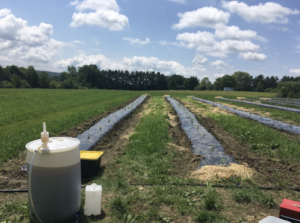 Working with Adam, we determined that we would use his existing drip irrigation system to apply the urine, which consisted of drip tape laid underneath black plastic mulch. Adam's drip system is fed from a well onsite. Normally, Adam uses 2 organic fertilizers through the hemp growing season: first is a 12-0-1 soluble organic fertilizer for the first 10 weeks after the plants go in the ground to stimulate foliar growth, followed by a 5-0-20 soluble organic fertilizer for the flowering and budding growth stage. We determined that we would take 4 rows with the same variety of hemp and replace the 12-0-1 fertilizer with urine for 2 of these rows, with the 2 others having the usual 12-0-1 fertilizer treatment. Adam indicated that in an ideal world, he would apply fertilizer more heavily than he actually does, so we decided that to one urine-fertilized row we would apply enough urine to deliver as much nitrogen as the normal 12-0-1 treatment, and to the other urine-fertilized row we would apply twice as much urine. The plan was that every time the rest of the field was fertilized with the 12-0-1, Adam would fertilize these 2 rows separately, using inline valves to control flow to the drip tape.
Working with Adam, we determined that we would use his existing drip irrigation system to apply the urine, which consisted of drip tape laid underneath black plastic mulch. Adam's drip system is fed from a well onsite. Normally, Adam uses 2 organic fertilizers through the hemp growing season: first is a 12-0-1 soluble organic fertilizer for the first 10 weeks after the plants go in the ground to stimulate foliar growth, followed by a 5-0-20 soluble organic fertilizer for the flowering and budding growth stage. We determined that we would take 4 rows with the same variety of hemp and replace the 12-0-1 fertilizer with urine for 2 of these rows, with the 2 others having the usual 12-0-1 fertilizer treatment. Adam indicated that in an ideal world, he would apply fertilizer more heavily than he actually does, so we decided that to one urine-fertilized row we would apply enough urine to deliver as much nitrogen as the normal 12-0-1 treatment, and to the other urine-fertilized row we would apply twice as much urine. The plan was that every time the rest of the field was fertilized with the 12-0-1, Adam would fertilize these 2 rows separately, using inline valves to control flow to the drip tape.
The urine was injected into the drip system with a small battery-operated pump, connected to an individual drip tape using a tee. During a drip irrigation session, Adam temporarily turned off the flow of water into the drip tape using an inline valve, ran the pump to inject the desired amount of urine into the line, and then opened the water valve again to resume normal irrigation. The process approximated the "water/urine/water" treatment in our controlled drip irrigation experiment. We provided 50 gallons of urine for the summer and a measuring container so that each row got the right dose of urine each week for the trial.
Adam found the application method worked well. He said, "the urine is much easier for me to use ... I have an organic fertilizer that is a powdered form, and it's water soluble, so I mix up batches, and then inject it into my irrigation line, and apply it that way, whereas the urine fertilizer was very convenient for use, because it was pretty stable in its barrel over a period of time." His usual fertilizer was not as stable, and needed to be re-mixed prior to each application.
Adam felt that the urine-treated crop was bushier and taller than his typically-fertilized controls (using a soy-based fertilizer approved for organic production), but he did not observe a difference between the "high dose" and "low dose" treatments. He was not able to conduct yield measurements as the entire crop was purchased "on the stalk" prior to weighing.
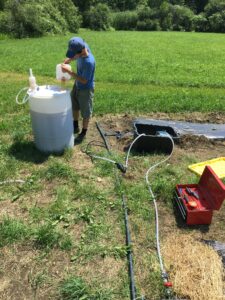
Arthur Davis, of Rich Earth Institute, with urine tank, battery, and drip irrigation system.
Elm Lea Farm is a working farm that is part of the Putney School, an independent high school in Putney, VT. Pete Stickney is the farm manager and was interested in using urine both because of its potential nutrient value to the farm, and also because of the educational value for the school. We initially considered applying urine using the farm’s irrigation system (connected to the lagoon used to manage liquid waste from their cow barn), but we determined not to do this due to a number of practical and logistical considerations. Instead, we decided to apply urine directly to hayfields at the farm using Rich Earth Institute's tractor-pulled urine applicator.
Pete had known about our work previously, and was excited to get a chance to try urine fertilizer on one of the farm’s hayfields. He applied dairy manure to the entire field, and then applied urine to one side of the field only at an estimated rate of 40lbs/acre of nitrogen, leaving the other side as a manure-only control. The picture shows the urine-fertilized section (lower right - darker green) and the manure-only section (upper left - lighter green).
Pete noted lusher production and greener color on the treated hayfield as opposed to the "control" which received manure only. His qualitative assessment of yield, based on the size of the windrows after haying, was an approximate 20% higher yield for the urine-treated field after the first cutting. He had intended to check for an improved plant population on re-growth, but did not have time to do this. The fields were cut once more, with no additional applications. (Normally he gets three cuts but the extremely wet July in southern Vermont precluded an additional cutting.) He noted that the improved yield and green color he observed from his one application did not carry over into his second cutting, so he felt a second (and potentially even a third and a fourth) application would be valuable, but he planned to re-evaluate in the spring to see if he did seem improved re-population of the plants.
Because of the question of whether urine-treated forage might affect palatability, Pete kept the urine-treated hay separate from the treated hay, and said he observed no difference - the cows appeared to enjoy all the hay.
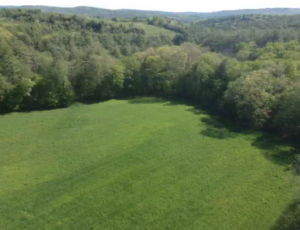
Hayfield with urine-treated section on right
Pete's Stand: John Janiszyn
John Janiszyn grows vegetables on a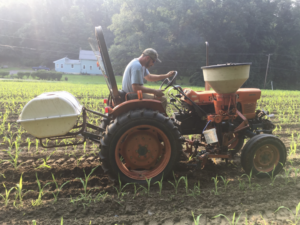 number of different plots in the Walpole, NH/Westminster, VT area. We worked with him to arrange a trial with sweet corn on a plot in Westminster, VT. The main challenge was to figure out the most effective (and easiest) way to apply the urine. John proposed that since he does a pass with his tractor down each row of corn to cultivate, that this would be a good opportunity for fertilizing with the urine. We built an experimental applicator using an old cabbage sprayer tank on a 3-point hitch. Urine exited the tank through a port on the bottom, then flowed through a ball valve and hose to a point under the tractor just above ground level, right in front of the cultivators. The goal was that urine would be immediately buried by the cultivating tines as they hilled the soil around the corn row. In practice we observed that no urine remained on the surface, indicating that this mechanism worked well. To control application rate in the field, we calculated a target tractor wheel RPM based on 1) the applicator’s characteristic flow rate (determined in a pre-test using
number of different plots in the Walpole, NH/Westminster, VT area. We worked with him to arrange a trial with sweet corn on a plot in Westminster, VT. The main challenge was to figure out the most effective (and easiest) way to apply the urine. John proposed that since he does a pass with his tractor down each row of corn to cultivate, that this would be a good opportunity for fertilizing with the urine. We built an experimental applicator using an old cabbage sprayer tank on a 3-point hitch. Urine exited the tank through a port on the bottom, then flowed through a ball valve and hose to a point under the tractor just above ground level, right in front of the cultivators. The goal was that urine would be immediately buried by the cultivating tines as they hilled the soil around the corn row. In practice we observed that no urine remained on the surface, indicating that this mechanism worked well. To control application rate in the field, we calculated a target tractor wheel RPM based on 1) the applicator’s characteristic flow rate (determined in a pre-test using 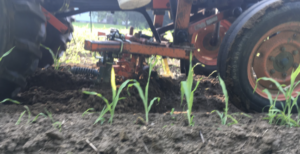 water); 2) the desired application rate; and 3) the tractor wheel diameter.
water); 2) the desired application rate; and 3) the tractor wheel diameter.
We fertilized 4 rows at a rate of approximately 55 lbs N/acre (rows 1-4), 1 row at a high rate of 103 lbs N/acre (row 5) and 2 rows at a middle rate of approximately 79 lbs N/acre (rows 6 & 7). Additionally, we fertilized a partial row at the lower rate of 55 lbs N/acre (row 8). We left 2 rows as unfertilized control rows and the rest of the field was fertilized with conventional urea fertilizer.
In mid-August, at the time of the first interview, the urine treated corn had done much better than the unfertilized controls: it was taller by about a foot, with stronger stalks, and about the same as the conventionally fertilized corn (urea), but that corn also had a side-dressing of extra urea which the urine treated did not. John felt that the high-dose urine treatment did better than the low dose. Overall, the entire crop suffered due to the excessive rain, but the urine-treated crop did not do any worse than the conventionally treated crop in this situation, and no differences in disease or pest pressure were observed.
John was interested in learning about any differences in nutrient uptake between the various treatments. We sent tissue samples of each treatment for analysis, and found the results of interest. In the attached report, the urine treatment is referred to as the "pasteurized urea product." The nitrogen and phosphorus were similar in all samples (except lower in the unfertilized control), but the potassium measurement was higher in the urine-treated rows compared to both the control and conventionally treated corn. John found this interesting because he normally applies a side dressing for potassium and speculated that urine fertilization might reduce the need for as much of this additional input. He said,"I'd like to try to see what it would be like if we could do a whole block of corn or something, side dressing with just urine and see what that would do. It seemed to do just as well as the conventional corn." Sulfur was also somewhat higher in the urine treatments as compared to both the control and conventional treatments. In addition, iron, manganese and zinc were all higher in the urine treatments as compared to both the control and conventional treatment.
Rebop Farm: Ashlyn Bristle & Abraham McClurg
Rebop Farm is a diversified hill farm in Brattleboro, VT doing small-scale dairy, raising pastured meats, and growing some specialty crops, including cold-hardy figs in a high-tunnel. Because of the high nitrogen needs of the figs, they were quite interested in using urine. Each year, they cut the figs all the way back to the ground, so they need to put on significant plant growth every growing season before setting and ripening the fruit. Ultimately, they are most interested in using a drip irrigation injection system like we used with Adam Hubbard, but the logistics were too challenging for using drip irrigations on such a small scale with different treatments, so they decided to apply the urine by hand for this experiment. In total, 2 rows were fertilized, each with 4 treatments: control (no amendments), composted manure only, urine only, and composted manure+urine. Urine dosages in the two rows ranged between 2.4 to 3.7 L/plant.
Ashlyn Bristle was very enthusiastic about the results she had observed through mid-August when the first interview/site visit was conducted. She described the urine-treated sections as having "the heaviest fruit-set" and best growth overall, and added "it's spectacular, fruit all the way down," and the crop was branching abundantly, providing opportunity for more fruit development. She felt that the best results at that point were being seen in her urine + compost treatment, where she estimated three to four times the usual fruit set. The next best fruit-set was in the urine only treatment, then the manure only, then the control. Unfortunately, at the end of the season Ashlyn reported failure to ripen in all but one fig variety. This problem occurred across all treatments, and was not attributed to urine fertilizer. She believed that the problem was the excessive rain the region experienced, which led to "wet feet" in the soil even within the greenhouse (located on a hillside), which is not optimal for figs. She also noted some disease, also attributed to the wet conditions, developing later in the season and hampering ripening.
In the future, she would move her application timing up to early May, and do a second application in early June, and then no further fertilization. She did observe some extra vegetative side growth with the urine treatments, which could be excessive so she would reduce fertilization after June.
Tapalou Guilds: Hanna Jenkins & Andy Loughney
Tapalou Guilds is primarily a cut-flower farm that also grows some hemp for CBD production. They decided to hand-apply urine to a bed of cut flowers alongside an unfertilized bed of the same varieties of cut flowers to do a side-by-side comparison. Both beds also received their usual treatment of compost tea. They also decided to hand-apply urine to part of their CBD crop in two different dosings. For the hemp, a 1X treatment of 1.86L per plant was divided into 2 fertilizations and a 2X treatment of 3.71L per plant was divided into 2 fertilizations. For the flowers, there were two 3’x50’ beds. One was treated with urine, one without. The low dose was matched to the alfalfa fertilizer, while the high dose was three times higher.
Hemp: Andy Loughney thought his "low-dose" treatment crop was bushier and taller than the high-dose, which was similar to his usual treatment. Because he was interested in any impacts on cannabinoid content, he submitted tissue from each treatment group for analysis. Upon receiving the results, he created this spreadsheet: Andy Loughney - CBDV trials
He wrote: "Just got the test results back as well, and they are exciting! The 6% overall rise in cannabinoid content is solid, but the real excitement comes from the huge gains in the cannabinoid that this variety was bred for (CBDV). It shows as CBDVA in the test results because that is the acidic form before heat or decarboxylation. Big gains: 32% in the lo-N, 25% in hi-N trial…. I'm quite pleased with the numbers for the CBDVA and overall cannabinoid content and we will certainly explore nitrogen application at this point, even if it cannot be urine for our organic operation at this juncture."
Cut flowers: Hanna Jenkins observed no major differences between the urine treated crops and those fertilized with her usual treatment, but some of the urine treated celosia, amaranth and sunflowers appeared taller, on average, than her controls. She was unable to quantify any differences in numbers of blooms (as she was pinching and pruning the plants throughout the season) but felt there were no negative outcomes. She had no significant disease or pest pressure on either the urine treated or control crops. The foliage on the urine application was darker, and appeared more "lush" which she found beneficial from an aesthetic point of view.
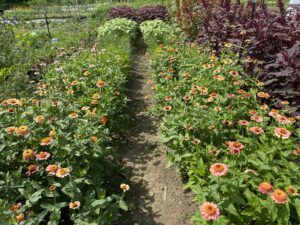
Tapalou Guilds Cut Flower trial - urine treated row is on the right
Hanna wrote: "Based on the results that I saw I plan on switching to using urine fertilizer as my predominant nitrogen source for field grown plants and potentially for use in high feeding plants in the hoop houses as well."
Farmer Interview Results and Discussion
Tatiana Schreiber interviewing Hanna Jenkins at Tapalou Guilds Farm August, 2021.
Below are some of the overarching perspectives and recommendations of farmer-partners based on interviews, email correspondence, and their participation in the field day and a final project meeting.
Motivations for Participation
Farmers were asked about their initial interest in participating in the project. All farmer-partners were intrigued by the possibilities of substituting urine for a part of their usual nutrient needs, trialing application methods, and participating in a research project that would yield valuable information while not requiring excessive time. As Adam Hubbard noted, "Learning is expensive, it takes time and effort, so [we we’re] trying to work out a system that minimizes my effort but gets results, and it's fun!" Closing loops (reducing external inputs), while keeping a potential pollutant out of the waste stream, were also key considerations. As Hanna Jenkins put it, "…one of the things for me is to look at things that may be defined or understood from a dominant standpoint as 'waste' and [thinking about] how we can reclaim things that we might label as wasteful and then through simple processes make them useful again?" Pete Stickney of Elm Lea Farm at the Putney school also noted the value of engaging students, faculty and staff who were interested in learning more about the possibilities of using urine fertilizer. Students at the school are currently doing urine fertilization experiments in one of their science classes, so this project was a way to extend that learning.
Decision-Making around Contamination & Risk
As noted above, several farmers were interested in further testing for microcontaminants. Motivations for understanding the risk from microcontaminants within urine fertilizer included: consumer perception, buyer perception, and resulting "purity" of the crop… Ashlyn Bristle of Rebop Farm summarized her feelings about the risks from microcontaminants: “I think there’s a risk in everything all of the time and I think we’re fooling ourselves to think that food can be this perfect place where we don't have that. I can understand the concern but I think it’s not very reasonable to be overly concerned about it when you weigh the pros and cons. And I always think about organic ag using non-organic compost, that being allowable and the pharmaceuticals that I know are in that. If that’s not a concern, I’m not sure why this is. And I trust the soil to break down what it needs to.”
Concerns around the residual pharmaceuticals in urine fertilizer were often closely linked to concerns of customer perception. This is seen in the case of Adam Hubbard’s concerns about his buyer’s perception of the purity of the hemp. Ashlyn Bristle also noted that the challenge of public perception also partly arises from the perceived categorical difference between human urine and manure, saying: “I think that there's this interesting marketing difference between what's coming out of our bodies and what's acceptable coming out of other animal bodies… I don't understand why those aren't the same in our minds, if there's an acceptable level, and that's acceptable on certified organic farms, I’m not sure why. Maybe it's the unknown…”
Specific Experiments/Problems noted
With regard to the specific experiments that each farmer undertook, there was interest in understanding not only yield, but potential to combat disease or pest pressure; potential to increase cannabinoid content of hemp, and in the case of greenhouse figs, to get stronger initial growth to boost chances of getting a harvestable crop within the growing season. The farmers did not note any significant problems with the application systems they used.
While the urine odor during application was significant, it was not more problematic than other farm odors. Once watered in, or covered with dirt, the odor dissipated rapidly. As Pete Stickney put it, "It wasn't entirely pleasant, spreading it, I'll say that, [laughing] but you know, when you're putting something good on the field, the factor of doing something good… overrode any unpleasant odors." Abraham McClurg also noted that,"personally I would rather have some urine smell and know what it is and where it came from than some sort of pelletized, powdered, whatever, stuff that I'm like,'I better wear a respirator, I can't touch it.'" In other words, knowing the providence of the fertilizer was more important than any odor.
Specific to high tunnel growing, Ashyln Bristle of Rebop Farm was interested in learning more about the effects of urine fertilization on protected culture and salt build-up: ”In protected culture, it would be really nice to do some soil sampling before and after so that we can figure out if there's salt build-up associated with it just because we're already sort of towing that line using animal based manures and compost. Just if it's going to add to how many times…we need to flush…it would be great to know.” Adam Hubbard agreed, saying: “Yeah, getting data on protected culture because that's big. A lot of people are growing in high tunnels…and having information for that would totally be valuable.”
Reflections on the Project as a Whole
Asked about price points for purchasing a urine-based fertilizer to make it feasible for themselves or fellow farmers, all expressed willingness to pay a price equivalent to their current fertilizer based on nitrogen content, and would consider paying slightly more because of other values (closing loops, keeping nutrients out of the waste stream) that they placed on this fertilizer, as long as it didn't jeopardize their overall profit margins. As Ashlyn Bristle put it, "if we can get it locally, if we know that we're supporting something meaningful then, then I think that we are willing to pay more than that, I think the question is…will it increase yield enough that it's worth it or not? So I think, to a certain extent, it's about how we feel about it and then beyond that it becomes about whether or not…it'll be another pebble that [sinks us] financially."
Thinking about how they might use urine on their farms in the future, participants imagined using it on different crops and pasture. Ashlyn noted, "I think the entire garden, and a lot of the fruit, would really benefit from occasional fertilization like that, and there's not always enough compost to service them, so I think it would strengthen the resilience of the garden and especially the specialty fruit if we could do that regularly, so it would benefit more than just the figs."
John Janiszyn was intrigued by the increased potassium, sulfur and micronutrients seen in the urine-treated corn. He noted, "you're getting, potassium along with the nitrogen when you're putting it in the soil, so as like something to side dress with, you know, a lot of plants need lots of potassium, so you can kind of get two birds with one stone, you know…."
Overall, participants seemed to find the project inspiring. As Adam Hubbard put it, "I really enjoyed it, I really support you guys. I'd take part in the future, I think you're part of something cool here…" Andy Loughney noted that the project seemed to free him up to consider using urine more widely, commenting that, "I think a large part of this whole thing, what I gather is, you know, just shifting people's perceptions about the use of urine. And so I think that that happened for me personally a little bit throughout this experiment."
Evaluating Farmer/Institute Collaboration
Rich Earth Institute practices a participatory action research approach in which developing respectful and equitable partnership between researchers and practitioners is a key goal. We took this opportunity to ask farmer-participants to candidly discuss what went well and whether there were any difficulties or concerns about the collaborative process itself. In all cases, the farmers expressed satisfaction with the collaboration, noting appreciation for the assistance Rich Earth provided with calculating dosage amounts, planning the experimental design, and facilitating an application strategy that would be successful. As Andy Loughney of Tapalou Guilds put it, "they really set us up for success, there seemed to be an understanding of what summer looks like farmers, so it was like two applications, came with a set of jugs, with lines on them, very straightforward, very simple, so we didn't have to think too much about the basics…". On the other hand, John Janiszyn noted that although he very much appreciated the dosage/method calculations provided, "it was different than how I would have done it, but I thought it was pretty brilliant, I thought 'Wait, how'd he do that? I want to know that..…' but yeah, great, it worked fine…" Further discussion with the farmer-partners with regard to co-design of application methods and provision of printed-out guidance may have been beneficial.
Farm Trials/Demonstrations Conclusions
Farmer participants were pleased with their experiences using urine on their crops, noting no adverse effects, and in most cases comparable or better yield and robustness as compared to their usual fertilization. They noted strong urine odor on application but did not find this unduly problematic. All felt they would use urine again, and would be willing to pay a price equivalent to their usual nitrogen-based fertilizers, or somewhat more, because of other values they ascribed to using human urine, as long as it didn't affect their profit margins. They had many recommendations for further experiments to validate these initial qualitative observations, and to hone their application methods to best suit their specific cropping patterns. Some of these suggestions have been incorporated into a new SARE partnership application, and will be considered for Rich Earth's ongoing agricultural research. They noted the need for further quantification of potential residual microcontaminants in urine, primarily so that they could communicate clearly with their customers, but also to increase their own confidence in its use. They also requested specific written guidance on crop application rates, NPK and micronutrient comparisons to other fertilizers, and educational materials to share with customers.
Drip Irrigation Emitter Trial Conclusions
For irrigation water with a hardness up to 124 ppm, urine can successfully be delivered via fertigation either by mixing it with irrigation water or by delivering it in an alternating fashion with the irrigation water. The three emitter types all performed well.
Urine fertilizer can be delivered through drip irrigation equipment when the irrigation water is as hard as 255 ppm, (and potentially higher,) provided that the urine and water are pumped into the irrigation system in an alternating sequence, to minimize mixing. All three emitter types worked well under this usage. In contrast, all emitters showed signs of clogging when fed a mix of 255 ppm water and urine, with the take-apart emitters suffering the worst clogging.
Education & Outreach Activities and Participation Summary
Participation Summary:
Seven farmers participated in the research project at five farm sites.
In order to disseminate the results of this research, we sponsored a farmer field day on September 22, 2021 at Adam Hubbard's hemp plot in Westminster West, Vermont. The event included viewing of demonstration plots, discussion of application methods and urine-derived fertilizer formulations, and presentation of the drip fertigation laboratory experiment results. Two of the farmer partners shared their experiences and ideas in a lively panel/Q & A discussion which was recorded for later consideration of the types of questions and ideas that emerged. At least 12 attendees participated, in addition to Rich Earth staff and farm partners. We distributed an educational document outlining our preliminary results from both the lab fertigation and the farmer interviews, Field Day Handouts (reduced size).
An update about this research was published in Rich Earth's online newsletter that goes to 1,300 recipients, Fall 2021 Newsletter. In addition, we wrote a press release that included mention of this grant along with two other SARE grants recently received. This was printed in the Brattleboro Reformer, Rich Earth Institute gets 3 grants .
Farm field day, Sept 21, 2021. Arthur David (Rich Earth) and John Janiszyn (Pete's Stand)
Farm Partner John Janiszyn brought urine-fertilized corn for farm field day participants to try.
We created a powerpoint presentation of the interim results of the project and shared this at our annual Rich Earth "Urine Summit" conference, attended by 200 participants. This presentation was given as part of a panel on Agricultural Uses for Urine Fertilizer. This panel was recorded and shared via Rich Earth’s Summit web page. It has received an additional 489 views as a Youtube video. Further discussion continued in a special breakout session on agricultural uses for urine fertilizer, which included about 15 participants. We revised our powerpoint presentation with final results which we shared at the NOFA–VT winter conference on February 22, 2022, with 30 people attending. We've uploaded the slides for this presentation in the information products section. In addition, we presented the project results to 45 students at Putney School, where the Elm Lea farm is located. Students learned about the hay field trial and then developed their own urine fertilizer experiments as part of their school’s “Pee Lab'' curriculum. We met with all the farmer partners via Zoom on March 4th, 2022, to evaluate results, share ideas, and brainstorm recommendations for follow-up research. Project updates were publicized on a regular basis via Rich Earth’s website (750 visitors/month), Facebook page (1,498 likes), and newsletter (1,300 subscribers).
In order to further disseminate the results of this research, we will:
- Publish in relevant publications (e.g. Natural Farmer, journal of Northeast Organic Farming Association, or Growing for Market.)
- Profile and acknowledge farmer partners in public presentations and newsletters.
- Share with the international network via the Sustainable Sanitation Alliance (SuSanA) platform
Learning Outcomes
Seven farmers participated in the project and all reported gaining knowledge, skills and awareness about how urine might function as a fertilizer on their farm. They each reported talking to other farmers (for example, Ashlyn Bristle reported discussing her experiment with members of a women's grass-farmers group, while John Janiszyn reported discussions with his father, also a farmer.) In addition, Tom Beaudry, a nutrient management advisor for farms in Vermont, New Hampshire and Massachusetts attended our farm field day and gained information about the five farm trials. A buyer for CBD hemp was also present at the field day and learned about the possibility of urine for use with hemp. Additionally, several farmers and educators were present at the project presentation and discussion at the Rich Earth Summit.
The primary areas in which farmers reported changes were in gaining knowledge about how urine applications worked for their particular crops as well as skills in using the application methods co-designed with Rich Earth. These farmers were already quite interested and enthusiastic about the potential for urine fertilizer, which motivated their participation. At the conclusion of the growing season, all reported continued interest, and noted opportunities for future applications, in some cases with different doses, different timing, or with different crops.
The farm partnerships developed in this study directly influenced a new SARE partnership proposal . For this proposed project, John Janiszyn would join us to further validate the results reported here, streamline his application method, and trial urine on new crops under mulch to explore nitrogen retention. Additionally, this project’s fig trial led to increased fruit set, encouraging new partner Jesse Marksohn (Yellowbud Farm) to propose this trial of urine for woody perennials in his nursery business.
ONE20-375 also identified farmer interest in understanding the perspectives of buyers and consumers to inform their marketing approach. This included concerns about the “purity” of a brand and a desire for educational materials for engaging with customers. The proposed project project will include research with farmstand and CSA customers to better understand their concerns and illuminate potential education strategies.
Finally, this project identified the need for an application guide for urine fertilizer. The guide proposed in the new project will equip farmers to make decisions about urine fertilization practices, including through comparing nutrient content of urine fertilizer to other commonly used fertilizers and amendments, and outlining effective practices for urine fertilization with various crops, under diverse conditions.
Project Outcomes
Some of the results farmers observed are noted in the case study sections above. All seven farmers reported that they are interested in using urine as a fertilizer in the future. All were positive about their experiences. Hanna Jenkins would like to use urine as her primary fertilizer for her cut flower operation in the future. Pete Stickney would welcome additional applications of urine for his hay crop (including after second and third cuts) and reported an approximate 20% increase in yield for his first cut hay. Adam Hubbard would be interested in continued use of urine, in additional applications, but expressed concern about potentially jeopardizing future organic certification, and would need that issue to be resolved before applying urine on a wider scale. Andy Loughney also stated that he would not use urine on his commercial hemp crop until the organic certification issue could be resolved, but was eager to make wider use of urine on his crops for home consumption, and future experiments. With regard to the observation that his lower-dose hemp crop did better than the high dose, he said he would now experiment between the lower dose and the high dose to find the "sweet spot," for highest cannabinoid production, since that is the basis for the economic value of his crop.
All farmer-partners had had some conversations with others about their participation in this project. Most reported people being intrigued and that some in the farming community were "really excited." Ashlyn Bristle noted that "the big black hole is human nutrient recapture and it’s so cool to me to have that be part of anything that’s happening on the farm." She did note that some younger employees were "a tiny bit grossed out by the smell" but felt that presented a valuable educational opportunity. She also noted only positive responses to her mention of the experiment on social media. Adam Hubbard noted that his buyer for his hemp crop was quite interested and supportive, although concerned that customers for the final product might have concerns because his "brand" is based on a concept of "purity." However, the buyer has not talked to customers about the urine treatment.
Hanna Jenkins also found the experiment valuable from an educational standpoint. She said that "some people would be turned off by [knowing the product was urine-treated] but I've come to terms with that's not the ideal customer for us then, you know, and I would really want to celebrate it and create education around it."
John Janiszyn has not talked to customers about the experiment but emphasized the importance of transparency, saying "I would probably come from a place of saying 'Yeah, I think this is a great thing, I'm glad to be a part of this project,' trying to figure out how to use this thing we're just sending down the drain, you know, we gotta change, we gotta start re-thinking on how we source our fertilizers, and you know, everything, really."
Drip Irrigation
Our main question in this study was to determine successful methods for using urine in drip irrigation systems. Our results show that even with very hard water, there are methods that will minimize and/or prevent clogging of emitters.
However, some questions are still outstanding. First is how evenly the urine will distribute within the drip system when it is applied using the water-urine-water method. Some preliminary observations suggested some uneven distribution, and this should be investigated further and on different scales, as a larger system may mitigate or exacerbate this effect. Another question is how urine will work with a standard fertilizer dosing machine like a Dosatron, in settings where soft or moderately hard water is available and the urine/water mix method is therefore appropriate.
In order to learn more and provide better informational resources to local farmers, we plan to pursue further field testing of urine in drip irrigation as part of our ongoing program of providing pasteurized urine to farmers in the Windham County, Vermont region.
Suggestions for future application methods and further research from farmer-partners
Each farmer had ideas about how they might do things differently if they were to do this again. Most indicated wanting to do the treatment earlier, and more often. For example, Pete Stickney would apply earlier, and include two additional treatments. Adam Hubbard, Ashlyn Bristle and Hanna Jenkins all wanted to do additional treatments over the course of the season. Each had ideas for improving the application method. Hanna would like to scale up her application, perhaps adapting a back-pack or drag-behind sprayer system with a wand for applying the fertilizer at ground level. Andy Loughney suggested a canister attachment to a hose, or pressurized tank (with the urine mixture at the appropriate concentration) in the field, with an attached hose.
John Janiszyn would need a larger tank and found the volumes of liquid urine needed daunting. He would prefer a dry product, as would Andy Loughney and Hanna Jenkins. Pete Stickney, on the other hand, finds the liquid product preferable, but a more concentrated product would be valuable. Adam Hubbard also found the liquid product ideal for use as part of his drip irrigation system.
Most farmers were interested in an application method that would enable larger scale use of the product. As an example, John Janiszyn had a number of ideas that we have since included in a new SARE Partnership Grant application. John was interested in saving labor by applying urine directly from 275-gallon IBC tanks that the Rich Earth Institute uses to deliver urine to farms. In place of the small, experimental applicator used in this study, which required frequent refills from the IBC tanks, he could simply pick up an entire IBC with the forks of his tractor. He would then connect the port on the IBC to the distribution hose on the tractor. The distribution system could be improved by having more than one nozzle, allowing multiple rows to be fertilized at once, with or without simultaneous cultivation. John also proposed trialing urine on other crops such as squash by applying urine to a row and then laying plastic mulch over top of the fertilized ground, and then planting into the row, thinking that the mulch could help trap nitrogen.
All farmers would like to see tissue samples (as we did with the corn crop, and for a small sample of Andy Loughney's hemp crop) for nutrient uptake, and cannabinoid content, in the case of hemp. In retrospect, building tissue sampling into the grant proposal for all farmers would have been beneficial. Several farmer-partners said they would like to see the urine product tested for microcontaminants. Adam Hubbard, in particular, was concerned that he not do anything on his land that could jeopardize the potential for organic certification in the future, so conducting this analysis would be helpful.
Other crops mentioned included tree crops (apples, hazelnuts, peaches), berry crops (raspberries), and horticultural crops (trees and shrubs) for landscaping. Using urine on long-season crops in high tunnels was also suggested, such as with tomatoes and specialty cucumbers. There was also interest expressed in using urine in conjunction with compost for soil building and reestablishment of native plants on degraded landscapes.
Each expressed interest in doing follow-up experiments on their farms and in learning from larger, replicated experiments. Pete Stickney noted the need for stronger data to validate his observations of increased yields. Ashlyn Bristle would like to see more specific study of the relationship between urine application and pest management, especially in orchard crops, because nitrogen levels are known to affect pest vulnerability so determining how much to use, and when with regard to pest pressure would be valuable.
Several of the farmers noted that while they appreciated the guidance they received from Rich Earth with regard to dosages to apply, they would have liked clearer indication of the nutrient composition of the urine in a form comparable to what they see on their currently purchased fertilizers and amendments. We have incorporated a plan for creating an application guide for farmers into our current SARE partnership application.
In addition to further education materials for farmers, several farmer participants were interested in the development of more resources for consumers and buyers. Andy Loughney of Tapalou Guilds said that part of the value of using urine fertilizer for their farm comes from the desire to be seen as “becoming part of the movement towards…closing these loops. You know, in an ideal world, that would mean something to the consumer. I'm not totally convinced that it does at this point, at least on a broad scale.” Andy felt there is value in education that can help to “create these more discerning customers and consumers who look for... broader consideration of capital.” Likewise, Ashlyn Bristle of Rebop Farm was interested in having more educational materials to use for communication with interested customers, saying “We have pretty high volumes through our farm store and I think it would have been really cool to have like a pre-written pamphlet or some kind of display or a blurb that we could send out in our email with a donation link or something for you guys. I think that there's some room to combine our marketing forces so that people get excited about this…there could be some cool synergy there.” Specifically, Adam Hubbard was interested in information on “caffeine, aspirin, and whatever the top four or five leading residuals are in urine…” as well as “the amount of nutrients that were taken out of the watershed” to communicate with their customers about the safety and environmental benefit of urine fertilization.
Limitations to the Study
Because we aimed to minimize effort invested on the part of participating farmers, we did not require farmers to gather quantitative data on yield differences or other impacts of their experiments. Each of these projects was a small scale, demonstration activity, with results that would primarily provide indication of the potential for using urine on these crops, rather than statistically significant data. The qualitative observations documented through our interviews were extremely valuable. We consistently asked farmers to provide any photos or other data they may have recorded, but farmer time constraints limited their capacity for detailed documentation. In retrospect, more assistance from Rich Earth staff in gathering this material would have been helpful to complement the qualitative material.
A further limitation concerns the current status of urine with regard to organic certification. Urine is not specifically prohibited by the USDA National Organic Program, but neither is it specifically allowed. A number of certified organic farmers who would have liked to participate in this project declined because they did not want to risk jeopardizing their organic certification. Even those who are not certified expressed concerns about experimental use of urine, until this issue is resolved. At the same time, we've noted that many farmers who practice organic methods (whether or not they are certified) have expressed interest in using urine in a variety of applications. Therefore, we continue to continue the best path forward to address this issue.
Who else might benefit?
Farmers and agricultural educators who focus on any of the crops investigated here will be interested in our results. In addition, those who work with the crops and horticultural plants (trees/shrubs) suggested for future study by farmer-participants will benefit from learning about the experiences of the farmers involved in this study. We have included research with woody plants/trees in our current SARE partnership application.
Information Products
- Rich Earth Summit Presentation (Conference/Presentation Material)
- Farm Field Day Handout (Fact Sheet)
- NOFA-VT Presentation Slides (Conference/Presentation Material)
